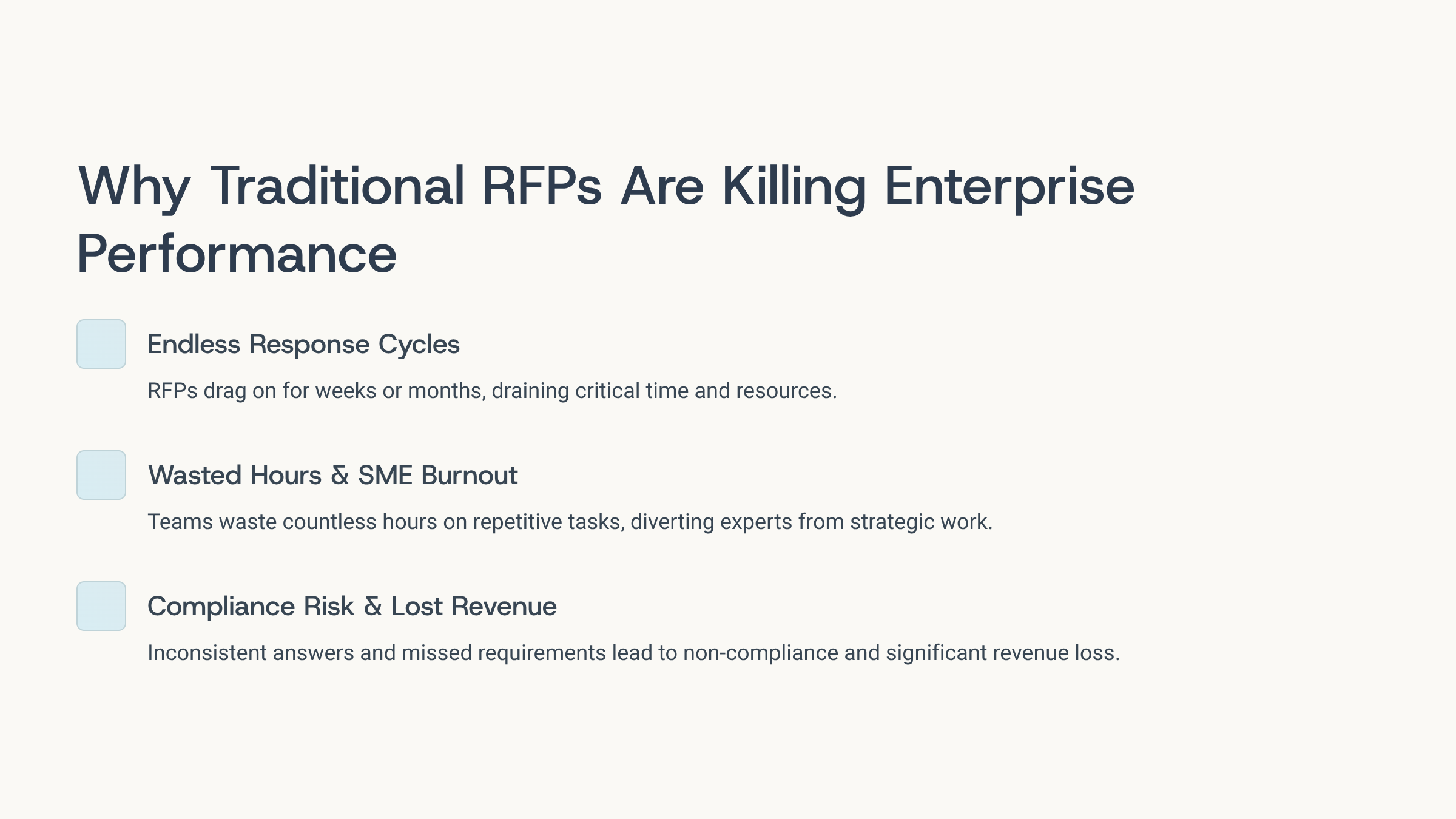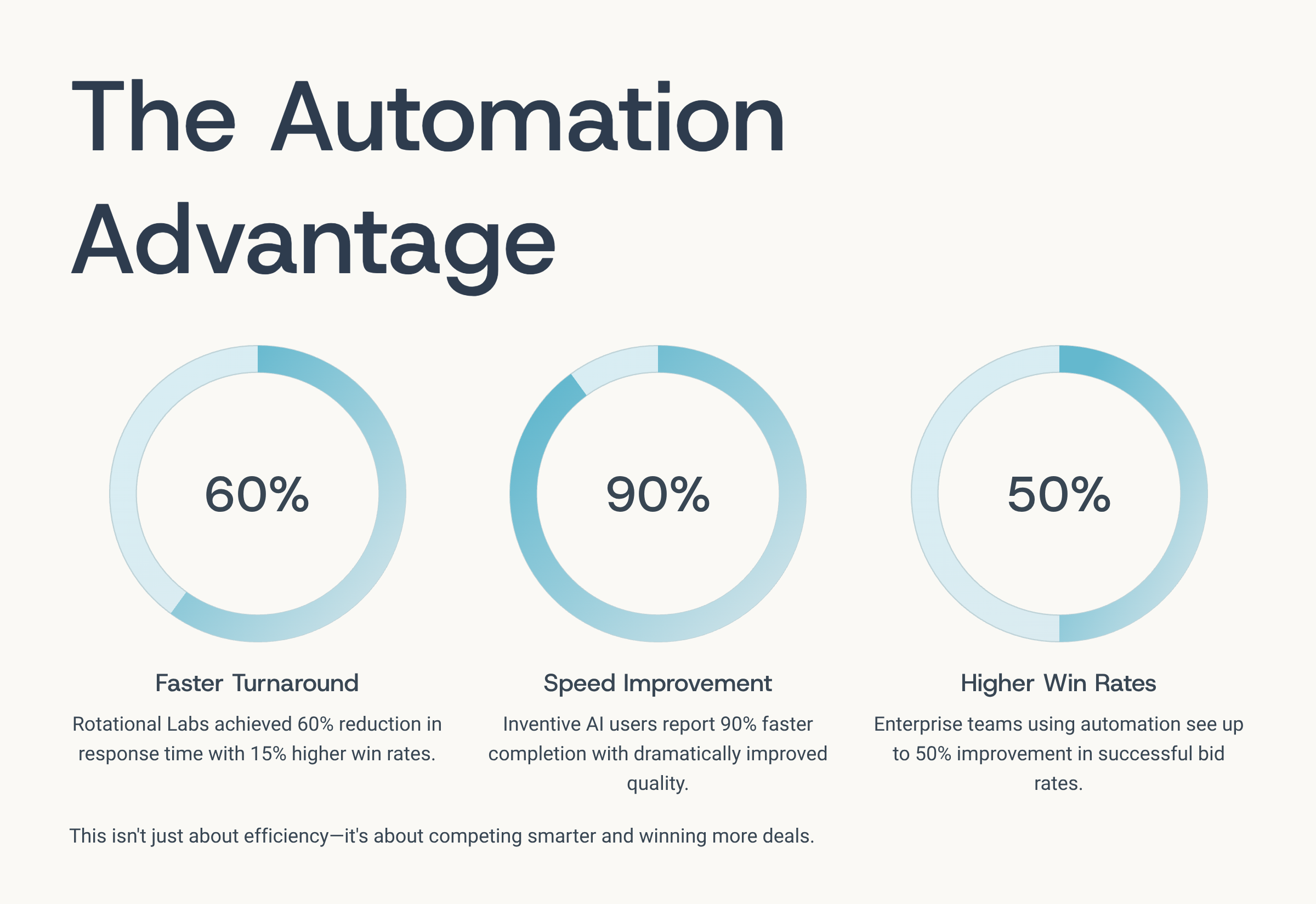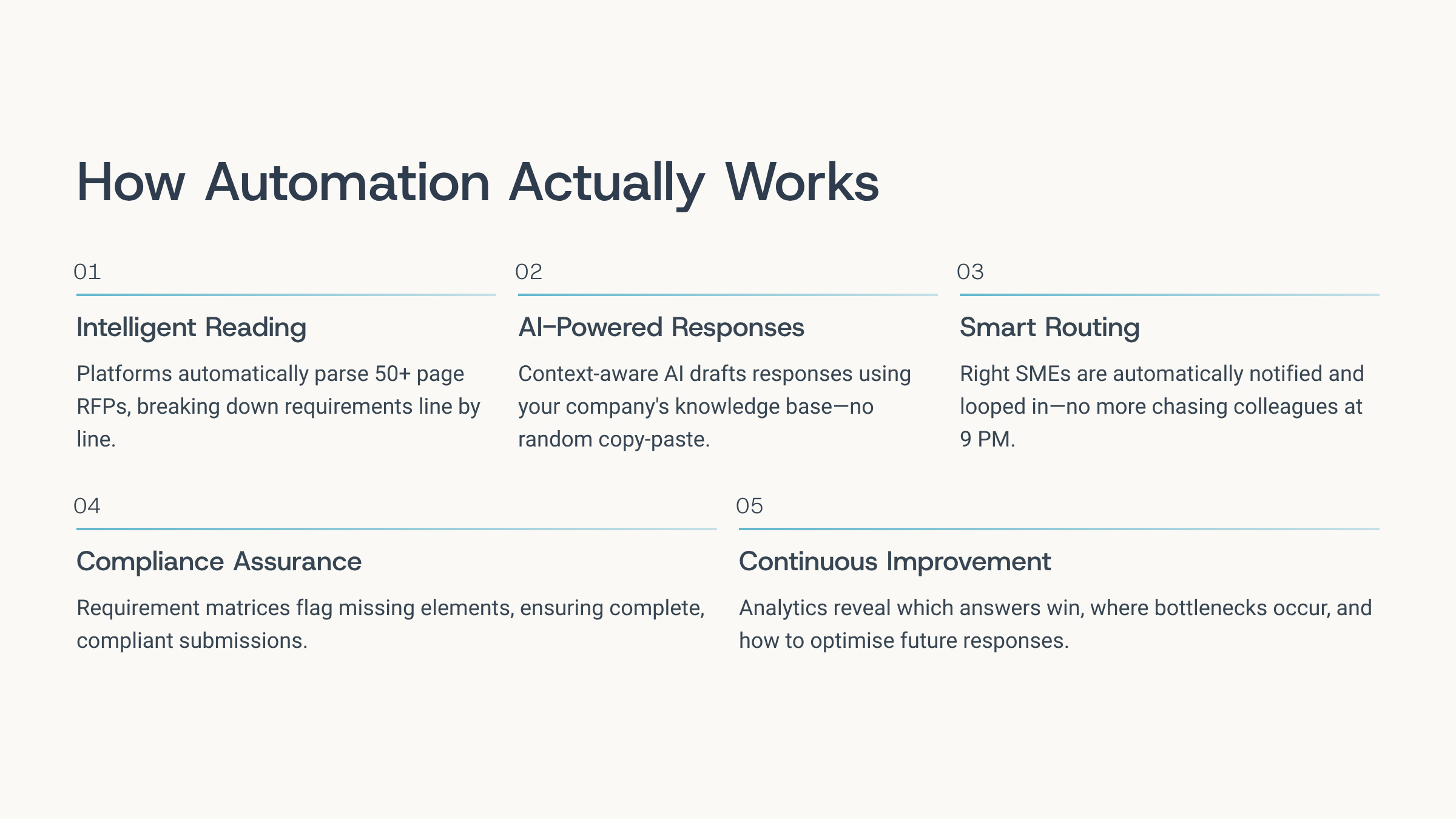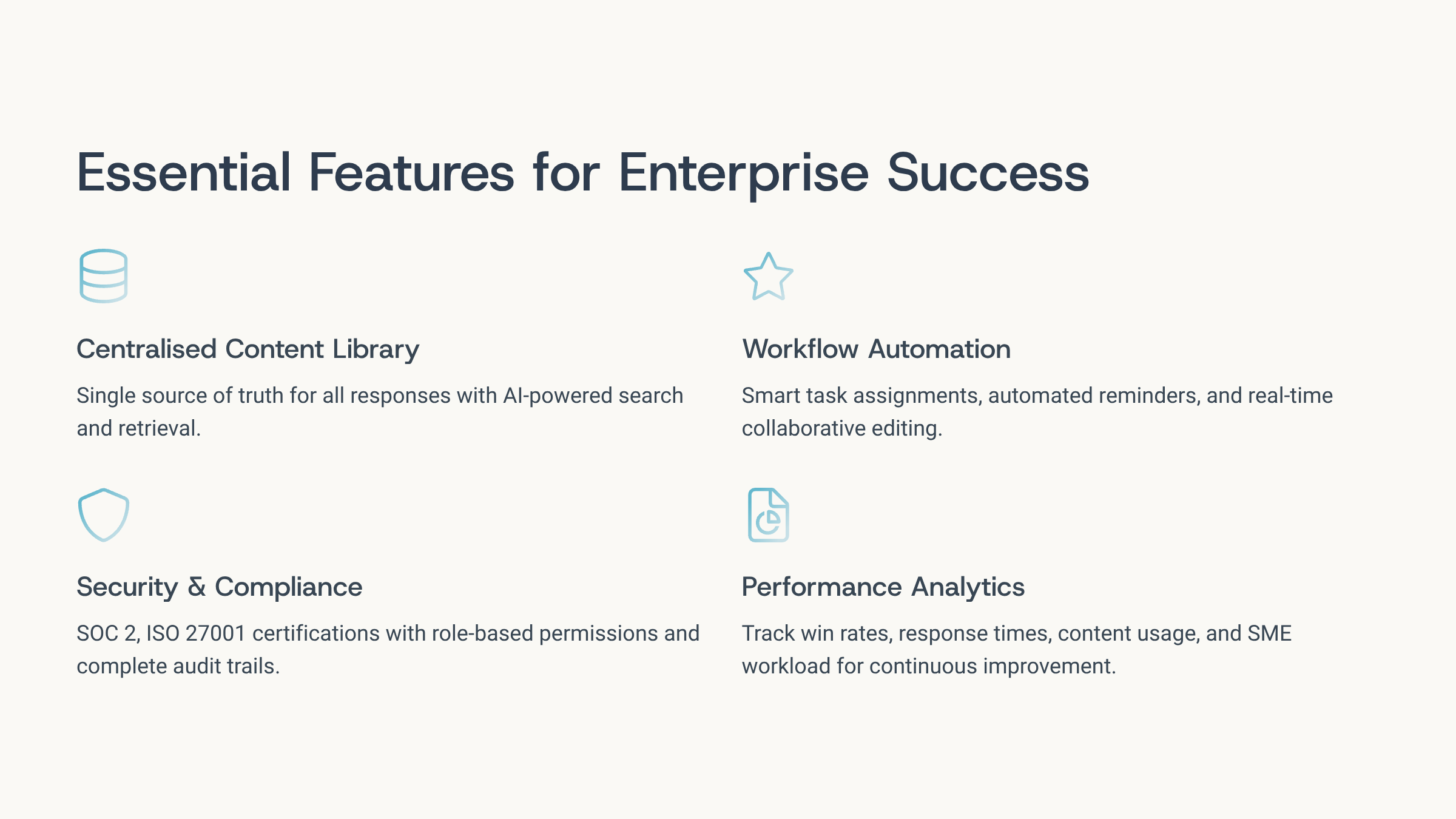RFP Response Automation Tools: From 10-Day Nightmares to 2-Day Victories
Article written by
Kate Williams

INSIDE THE ARTICLE
SHARE THIS ARTICLE
Summary
Responding to RFPs manually is killing your team’s time, morale, and win rate. This guide breaks down how RFP automation tools can turn 10-day marathons into 2-day victories—with real ROI math, implementation tips, and feature comparisons. If you're still doing RFPs the old way, you're already behind.
All of you might agree that RFPs are one of the most high-stakes, least-favourite parts of the sales cycle. But how many of you know that they don’t have to be?
RFP response automation tools have changed the 10-day nightmares of messy and doubtful RFP responses to clean and clear 2-day wins. They take the chaos of manual RFPs and replace it with something structured, scalable, and even (dare I say) strategic. Teams using these tools cut turnaround by 60–90% and improve win rates by up to 50%.
I see this as a revenue engine transformation rather than an operational shift. Let me walk you through why the old way is broken, how automation changes the game, and which tools are shaping the future.
What is RFP Response Automation?
Alright, let’s cut through the jargon. RFP response automation is the use of software and AI to take the grunt work out of replying to Requests for Proposal (RFPs).
If you’ve ever spent hours digging through old proposals for that one perfect compliance answer, or sat in a “war room” trying to assign 300 questions across sales, legal, and security… Automation is basically the fix for that chaos.
Here’s what it actually does:
- Reads the RFP for you:Instead of manually parsing 50+ pages, the platform breaks down requirements line by line.
- Suggests answers automatically:Using AI and your company’s knowledge base, it drafts context-aware responses (not random copy-paste).
- Centralizes your content library:All those boilerplate answers, product specs, and case studies live in one searchable hub.
- Routes tasks smartly: The right SMEs are looped in automatically; no chasing via Slack at 9 PM.
- Keeps you compliant: Requirement matrices flag what’s missing, so you don’t accidentally submit an incomplete response.
- Tracks and improves: Analytics show which answers win, where bottlenecks happen, and how to speed things up next time.
So basically, manual RFPs = 10 days of slog. RFP response automation = 2 days of focused, high-quality work. And the kicker? The responses go out sharper, more consistent, and more aligned with your brand.
It’s how you stop treating RFPs as a box-ticking exercise and start treating them as strategic brand moments that actually close deals. Now let's dive a little deeper into the tools that actually do this job.
Why Traditional Manual RFPs Drain Enterprises
Here are a few common reasons why traditional RFPs are so painful.
- Long Response Cycles Manual processes average 6–10 days per RFP. For global enterprises or public sector bids, timelines can stretch into months.
- Inefficient Hours Lost Teams waste hours searching for “that one doc,” hunting through old inboxes, or asking SMEs to repeat the same answer (“When was the company founded?”—again).
- Human Error & Compliance Risk Copy-paste chaos leads to missed questions, inconsistent answers, or outdated compliance language. Evaluators don’t give partial credit—they just score you down.
- SME Burnout Legal, security, finance, and technical experts are constantly pulled from strategic work to answer boilerplate questions. Proposal fatigue kills morale and productivity.
- Lost Opportunities According to KPMG, 12–40% of contract value is lost due to poor contract and proposal management. Slow or sloppy submissions don’t just risk one deal—they erode credibility across the board.
This is why many sales leaders privately admit they’d rather walk away from some RFPs than waste 20 hours on an unscalable process. So, why wouldn't anyone switch to automation that can transform the way RFPs are handled and save time, effort, and energy for everyone involved?

How Automation Transforms the RFP Process
When you flip the script. Here’s what RFP automation looks like in practice:
- Upload the RFP The platform parses every requirement automatically.
- AI Auto-Drafting Large language models generate first drafts in minutes, trained on your historical data and brand voice.
- Smart Collaboration The right SMEs are auto-notified. They validate or refine answers inside the platform—no endless email chains.
- Compliance Assurance Requirement matrices highlight gaps so nothing critical slips through.
- Analytics & Continuous Improvement Dashboards track bottlenecks, win rates, and content freshness for future responses.
Measured impact:
- Rotational Labs: 60% faster, 15% higher win rate
- BuildOps: Cut cycles from 2 weeks to <1 week
- Inventive AI users: 90% faster completion, 50% higher win rates
This isn't even about efficiency anmore—it's about competing smarter.

RFP Response Automation Tools
The RFP response platforms are your proposal autopilot. They take everything you and your team already know—approved answers, product documentation, compliance language, case studies—and centralize it in one place. Then they layer AI on top to:
- Suggest or auto-generate draft responses
- Route questions to the right people (without you begging via email)
- Keep everything compliant and consistent
- Give you analytics on what’s actually working
It doesn’t replace people. It removes the repetitive noise so your SMEs and sales teams can focus on narrative, differentiation, and strategy. The stuff that actually wins deals.

Essential Features of Enterprise-Grade RFP Tools
When evaluating platforms, enterprises should look for these must-have features:
- Centralized Content Library: One source of truth for all responses.
- AI-Powered Response Generation: Context-aware drafting with tone/style adaptation.
- Collaboration & Workflow Automation: Task assignments, reminders, approvals, real-time editing.
- CRM & Knowledge Hub Integrations: Salesforce, HubSpot, Confluence, SharePoint, Google Drive.
- Analytics & Reporting: Win rates, response times, content usage, SME load.
- Compliance & Security: SOC 2, ISO 27001, role-based permissions, audit trails.
- Flexible File Handling: Parse Word, Excel, PDF, and structured questionnaires.
- Branded Templates: Professional, consistent proposal design.
Enterprises should think of these tools as strategic revenue systems, not just databases.

Top RFP Response Automation Tools in 2025
When it's time to switch to automation, you might end up in a pool full of RFP response automation tools. Here are a bunch of tools that have been evaluated and are doing wonders for enterprise teams:
1. SparrowGenie
SparrowGenie is a sales-enablement platform that is designed with enterprise sales and pre-sales DNA. It focuses on making RFP and proposal management a completely hassle-free process.
Strengths:
- Rapid proposal generation via secure AI
- Smart content library with battlecard support
- Slack, Teams, and browser extension integrations
- Real-time collaboration across sales, marketing, and legal
- AI “pre-sales engineer” functionality for contextual answers
Best For: Sales and pre-sales teams juggling complex enterprise RFPs under tight deadlines.
Unique Value: SparrowGenie blends secure AI with real-time knowledge access, reducing turnaround times dramatically while boosting response quality.
2. Loopio
Loopio is an enterprise-grade RFP response platform focused on streamlining content management and collaborative proposal work. It empowers large teams to accelerate complex responses with automated first drafts and a robust, AI-enabled content library.
Strengths:
- Intuitive interface for non-technical users
- Robust content library management
- AI-assisted drafting of responses
- Collaborative workflows across departments
- Strong CRM and sales platform integrations
Best For: Large enterprises with dedicated proposal teams who can maintain knowledge bases consistently.
Limitations: While powerful, Loopio is less AI-native than newer entrants. It’s excellent for content organization but lags behind in generative automation depth.
3. Responsive.io (formerly RFPIO)
Responsive.io, the rebranded RFPIO, is a flexible yet powerful platform trusted by organizations of all sizes for RFP, RFI, and security questionnaire automation. It shines in collaborative editing, real-time project tracking, and scalable integrations with widely used business tools.
Strengths:
- Real-time collaborative editing
- Automated reminders and project tracking
- AI-generated answer suggestions
- Broad integration ecosystem (CRMs, productivity tools)
- Analytics dashboards for visibility
Best For: Organizations managing both small and large volumes of RFPs, needing scalable workflows and high process visibility.
Unique Value: Responsive.io excels in progress tracking and visibility—proposal managers know exactly where bottlenecks are and who owes what.
4. AutoRFP.ai
AutoRFP.ai is a next-generation, AI-first RFP automation tool built to maximize automation by generating answers directly from historical responses across languages and regions. It emphasizes strong compliance controls and unlimited user collaboration for global enterprises.
Strengths:
- AI-generated responses from historical data
- Global language support
- Compliance reviews and accuracy checks
- Unlimited user support for enterprise collaboration
- Security certifications: SOC 2, ISO 27001
Best For: Enterprises seeking maximum AI automation with minimal manual upkeep.
Unique Value: Adapts tone and style for different audiences and regions, making it a strong fit for global RFP teams.
5. Inventive AI
Inventive AI is designed from the ground up as a fully generative, AI-native proposal workspace, supporting teams with virtual agents and continuous content updating. It provides seamless collaboration, smart content search, and deep automation to dramatically accelerate proposal creation.
Strengths:
- Specialized “AI agents” act as virtual proposal assistants
- Unified content search across repositories
- Real-time collaboration across teams
- Automated content freshness checks
- Intuitive user interface
Results:
- 90% faster RFP completion
- 50% higher win rates reported by customers
Best For: Enterprises ready to embrace AI-first workflows and maximize proposal velocity.
Benefits of RFP Tools for Enterprises
Adopting RFP automation isn’t just about saving time—it’s about transforming proposals into a strategic revenue driver.
- Win More Deals: Automation boosts win rates by up to 50%.
- Boost Revenue Capacity: Handle more RFPs without adding headcount.
- Ensure Compliance: Automated requirement checks reduce risk.
- Protect SME Time: Reduce burnout by removing repetitive admin.
- Strengthen Brand: Polished, consistent responses build trust with evaluators.
- Data-Driven Insights: Analytics highlight winning themes, enabling smarter strategy.
In an era where AI-enabled competitors are already automating, enterprises that cling to manual RFPs risk being left behind.
How to Choose the Right Tool
Here’s a simple framework for evaluating:
- Team Size & RFP Volume: High-volume teams need workflow-heavy tools while smaller teams may prefer intuitive platforms.
- Compliance Needs: Regulated industries should prioritize tools for certifications and privacy controls.
- AI Maturity: If your org is AI-ready, choose platforms that are versatile for your AI purposes and thoroughly reliable at the same time.
- Cross-Functional Collaboration: For organizations where sales, legal, and marketing all contribute, you need to ensure that the platform has seamless navigation and is easy for all your teams to collaborate.
Depending upon your team's requirements, you need to choose the perfect automation tool that will make your team's life easiest.
Wrapping It Up
RFP response automation tools have redefined the game from 10-day grinds to 2-day wins. They have become strategic weapons for winning enterprise business.
And if you’re looking for a solution that combines speed, security, and sales-focused intelligence, SparrowGenie is worth exploring.
Because in today’s market, the only teams still stuck in 10-day nightmares are the ones without automation.
Ready to see how AI can transform your RFP process?
Product Marketing Manager at SurveySparrow
A writer by heart, and a marketer by trade with a passion to excel! I strive by the motto "Something New, Everyday"
Frequently Asked Questions (FAQs)
Related Articles

How to Build the Perfect Inbound Sales Tech Stack in the AI Era | 2025

Content Libraries for Proposals: Your Edge for Consistent Wins
